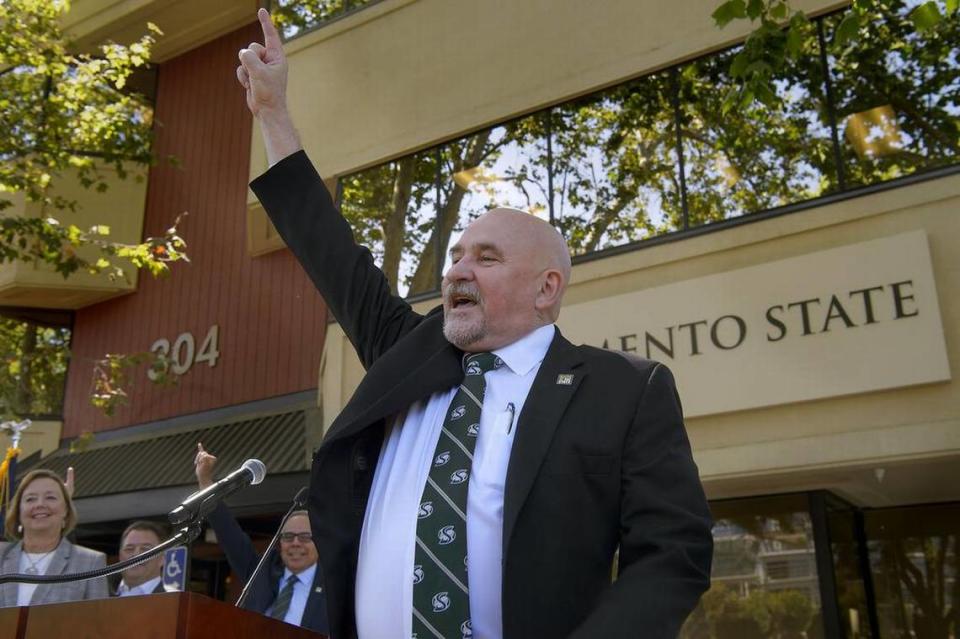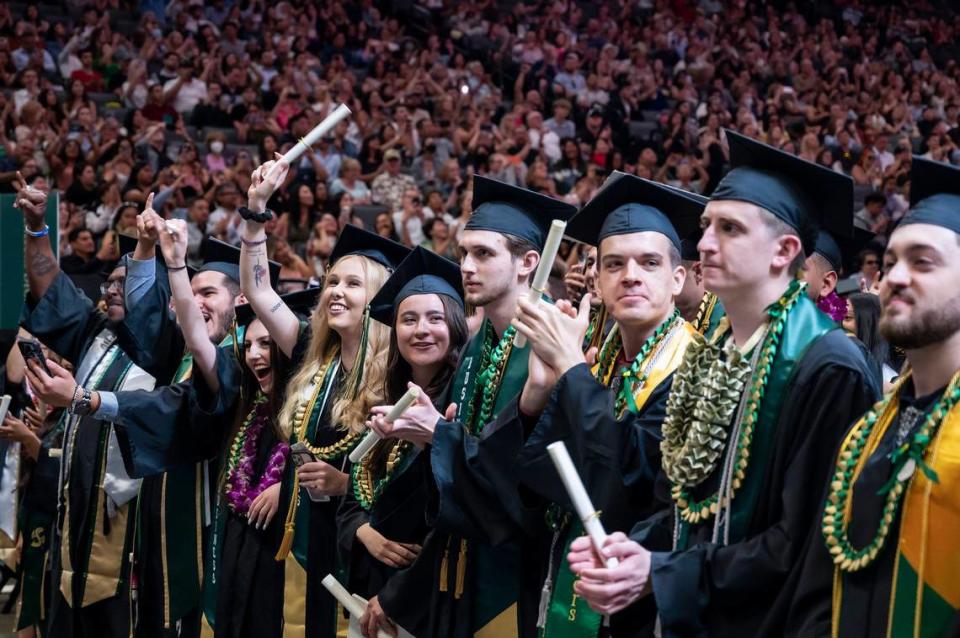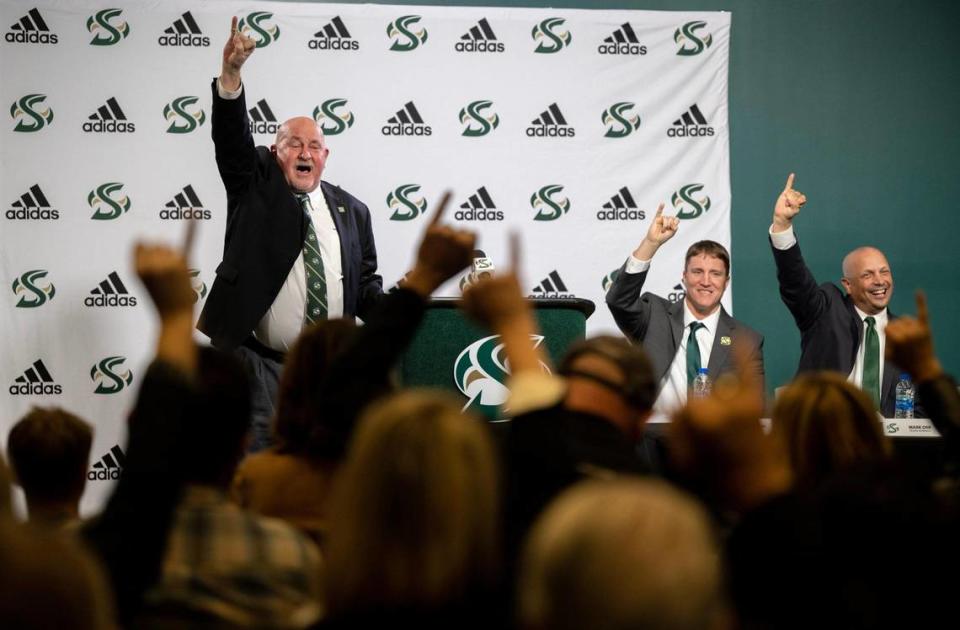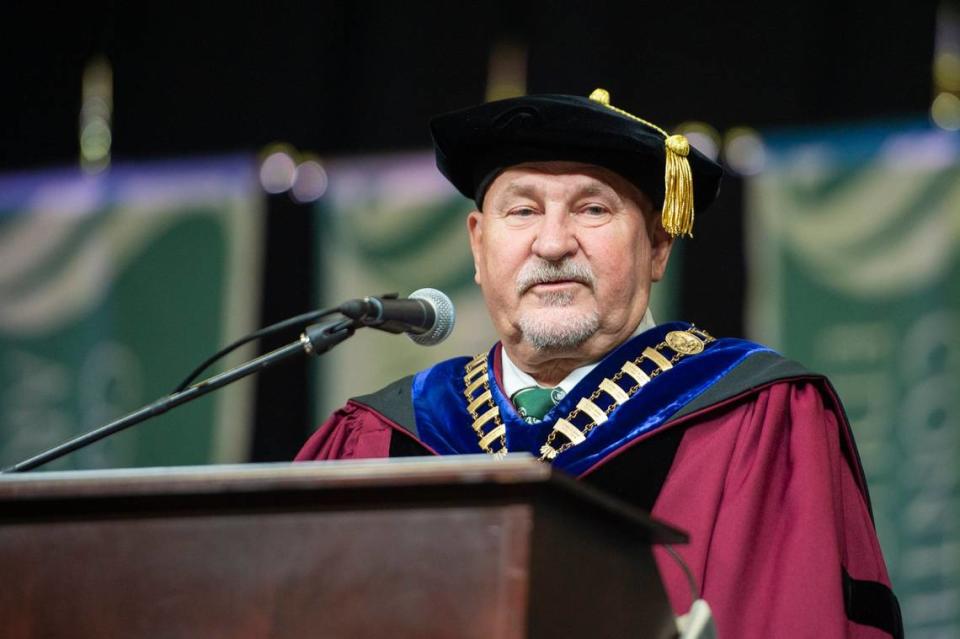Robert Nelsen says one last ‘Stingers up’ after 8 years as Sacramento State president
Robert S. Nelsen will conclude his service as president of Sacramento State on July 15, passing the role on to alum J. Luke Wood.
Mayor Darrell Steinberg lauded Nelsen as a “giant” and “man of great conscience,” renowned for his dedication to raising the four-year graduation rate — which more than tripled during his eight-year tenure — and remembered as a symbol of Hornet spirit.
His final act as president will be in crowning the champion of the Homeless World Cup, July 8-15 at Hornet Stadium.
The Sacramento Bee sat down with Nelsen to talk about his time in Sacramento, his hopes for the future of Sacramento State and where he’s going next.
The following is an excerpt. The full interview was edited for clarity and brevity.
Q: Did you create the ‘Stingers up’ mantra?
A: When I was interviewing for the job, I found out that they used to do it a long time ago. So I resurrected it.
I needed Sac State to say we’re No. 1. Too many people did not think Sac State was No. 1 when I came here. And I believed it was No. 1. I wanted everyone to shout it, and shout it with me, and that’s why I shout so loudly. And “Stingers up” was an opportunity for us to say that we have an identity, that we’re a Hornet family.

Q: You were a first generation college student, as is 30% of Sac State’s student body. How did your beginnings and educational path shape your priorities as university president?
A: I don’t think a lot of people understand how difficult college is. And it isn’t just first-generation, it’s everybody. You’re ripped away from your family. A lot of your high school friends aren’t with you. It’s not easy, it’s not easy at all.
For me, I didn’t know what it meant to go to college. And so many of our students don’t have that experience either. So the ability to transcend and be able to go on and be successful is huge.
I dropped out and I had to come back.
Q: Do you think some of the reasons you dropped out parallel the reasons some Sac State students have struggled to finish in four years?
A: I had a son, Seth. I decided I had to put food on the table. I got a job; it paid $14,000 a year.
After a year of doing that job, (wife) Jody told me, “You’re boring. You’re not writing any stories, you’re not reading any books. We’re going back to college, and you’re going to graduate.”
My experience is what many Sac State students have. That it’s hard financially. My miracle story is that I had Jody, I had a wife, I had someone who loved me. She made me go back.
Q: That’s an amazing partnership. Was she able to finish her college degree?
A: She had to put me all the way through my PhD. There’s what’s called, “Putting Hubby through College,” a PhC. I got a PhD, she got a PhC. Then she said, “F you, I’m going back to college.” She got her degree and became a vice president of business affairs at two colleges.
Q: Raising the four-year graduation rate was one of your biggest efforts and impacts at Sac State. Could you tell me more about what that has meant to you?
A: They didn’t believe in our students. They didn’t believe they could graduate in four years. I did, and I came here and the whole work was to convince everyone that they could graduate in four years. I did. The whole work was to convince everyone that they could. That they were smart enough, that we would find ways so they could graduate in four years. Not everyone can. I know that, I couldn’t.
We finally succeeded in getting our graduation rates to increase. Now they’re at 30.8%, which is at 272% more than when I started. (Sacramento State’s four-year graduation rate was 8.8% in 2016, according to the university.)
But I think the real number is the $440 million saved by all the students who graduated in four years instead of six years. That’s $440 million that they would’ve taken out in loans, or had to have their parents pay, or would’ve had to earn on their own to be able to put food on the table. $440 million saved because students are graduating in four years.

Q: What were some of your quieter wins as president?
A: Let’s go a loud win. How about the football team? The basketball team, the gymnastics team? Six championships. Those were great.
There are other wins that are more important to me, probably. The Asian, Pacific Islander and Desi American center; the Dreamers resource center for our DACA and our Dreamers students; our Native American center; the MLK center. All of those were really critical for what we’re trying to do.
Watching the students graduate. My final graduation ceremony, which will forever be emblazoned in my heart, was at Folsom Prison. We graduated students with communications degrees. It also happened at Mule Creek State Prison.
It isn’t about me. It’s about the amazing people in social sciences. Faculty went into the prisons to teach. Those are the heroes. I ain’t nobody.

Q: I read that you turned down the university’s offer of a multi-million dollar home in Fair Oaks, opting for a less expensive home in East Sacramento. Tell me more about that.
A: I didn’t think that story would ever get out! It was supposed to be a hidden story.
They had purchased a house for us – it was a multi-million dollar house – and it was an amazing house. It had an infinity pool, a basketball court outside. When you went inside it had marble columns, a cigar room, it had a panic room. And when Jody and I walked in, Jody looked at the place and said, “conspicuous consumption.” We turned around and left. The house is now why we have the Servery on our campus, the dining commons and everything else – that’s where the money went.
Jody and I bought our own house. It was a great house down on 45th and J. We didn’t need a university house.
Q: It seems like a big part of your leadership ethos is about community and community spirit. Where does that come from?
A: There are two sources, and I’m going to talk about the raw source first. Stephon Clark. His death tore apart our university. So did George Floyd’s death. We, as a university, need to be a part of healing Sacramento. If I have a legacy, I hope it is that we are a healing university. That is critical.
For me, I don’t see any reason for a university to exist if it isn’t involved in the community and changing lives in the community. This is our mission statement: transforming lives by preparing students for leadership, service and success.
Q: You mentioned legacy. I’m curious if there’s any unfinished business that you hope the new president, J. Luke Wood, carries forward.
A: There’s a lot that I hope he carries forward. There’s a big burden on his shoulders as he comes forward. We have to go on winning football and basketball and gymnastics and all the other sports.
My one ask of President Wood is always remember that the students are why we are here. Without the students, there wouldn’t be a university. Let’s be there to support them, let’s be there to help create the next great Hornet family.
A lot of people have asked me to leave a letter for the new president on my desk. I’m not going to do it. I’m just going to leave an email that says, ‘The university must always err on the side of saying yes.’
Q: For next steps, I hear that you’re going back to Texas. Can you share with us how you think you’ll be spending your time there?
A: I want to see us work at creating better pathways for immigration. Better pathways for all of those kids that are crossing. Safer pathways for them. I am going down there, and I hope to work on poverty and I hope to work on immigration reform and I hope to work on remembering what it means to be a nation with arms out for everyone.
Q: Are you going to be working outside of university walls?
A: I’m outside the university walls. There are so many 501(c)(3) (nonprofit organizations) that are working to help everyone else. Universities are great, but I’m going to shed my cocoon and go out and work with the community.
Q: That marks a big step for you because you’ve been within a university setting for decades.
A: Since 1989, yep. ‘Bout time, huh?
Q: You’re leaving higher education at a time of turmoil, between the recent Supreme Court decisions on affirmative action and student loan debt. How do you feel about American higher education as you reflect on multiple decades inside of it?
A: Too many people know me as a pessimist. I’m not. I believe in the power of higher education. I believe that we have made some serious mistakes in our country recently with regards to affirmative action, with regards to loans.
But I also believe that higher education has always, always won out in the end, and I think it will again. Look at our country’s history. Look at the horrible things that have happened in the past – segregation, racism, poverty. Look at what we did when we said, “Just say no to drugs.” We’ve come beyond that.
I believe in us. More than anything, the only reason I’ve done this since 1989 is I believe in our students. They will make our future. Too many times we say they are our future. No. They will make our future.


